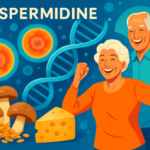Senescent Cells and Aging
Imagine your body as a bustling city. Cells are the tireless workers, constantly dividing and repairing to keep everything running smoothly. But as we age, some of these workers become “worn out” and enter a state called cellular senescence. These senescent cells are like grumpy retirees who refuse to retire, lingering on and causing trouble.
What are senescent cells?
Senescent cells are cells that have stopped dividing due to damage or stress. While this might seem like a good thing, preventing uncontrolled cell growth, it comes with a twist. These stubborn cells don’t die off as they should. Instead, they become “zombies”, releasing harmful chemicals called the senescent-associated secretory phenotype (SASP).
The good, the bad, and the ugly of senescent cells:
- The good: Senescent cells play a crucial role in some situations, like wound healing and preventing cancer. They act like alarms, calling in immune cells to clear debris and prevent further damage.
- The bad: The problem arises when senescent cells accumulate over time. Their persistent SASP creates chronic inflammation, damaging nearby healthy cells and contributing to age-related diseases like heart disease, diabetes, and Alzheimer’s.
- The ugly: Senescent cells can even spread their “grumpiness” to neighboring cells, accelerating the aging process in a domino effect.
Why are senescent cells problematic?
While senescent cells play a role in wound healing and preventing cancer, their accumulation over time becomes detrimental. The chronic inflammation caused by SASP damages nearby healthy cells, contributing to various age-related diseases like:
- Heart disease
- Diabetes
- Alzheimer’s disease
- Arthritis
- Macular degeneration
Can we combat senescent cells?
The exciting news is that researchers are exploring ways to target senescent cells:
- Senolytics: These drugs aim to selectively eliminate senescent cells, improving health and potentially delaying aging.
- Senostatics: These drugs aim to block the harmful effects of SASP, preventing the spread of cellular “grumpiness”.
Senolytics In Details :
Senolytics are a new class of drugs specifically designed to target and eliminate senescent cells. These drugs work in various ways, including:
- Inducing apoptosis: Triggering programmed cell death in senescent cells.
- Disrupting their survival pathways: Depriving senescent cells of the signals they need to stay alive.
- Neutralizing SASP: Reducing the harmful effects of the substances released by senescent cells.
The examples of senolytic drugs are Dasatinib, Quercetin, Fisetin and Navitoclax.
The potential of senolytics:
Early research on senolytics in mice has shown remarkable results, including:
- Improved lifespan and healthspan
- Reduced disease burden
- Enhanced physical function
What can you do?
- Maintaining a healthy lifestyle: Eating a balanced diet, exercising regularly, and getting enough sleep all contribute to cellular health.
- Managing stress: Chronic stress can accelerate cellular damage and promote senescence.
- Staying informed: Keep yourself updated on the latest research on senescent cells and potential interventions.
- Supplements : Fisetin , Quercetin however more research is required in this area .
Understanding senescent cells is a crucial step towards unlocking the secrets of aging and promoting healthy longevity. The future of aging might involve finding the right balance, allowing these cellular “retirees” to play their beneficial roles while preventing them from wreaking havoc on our health.










